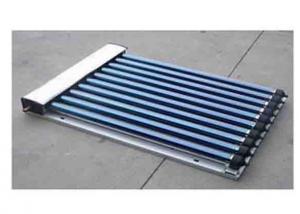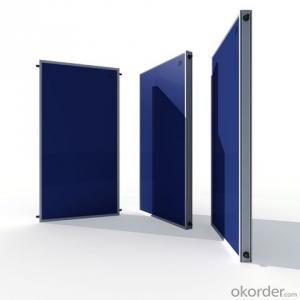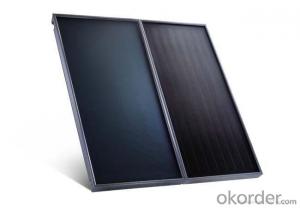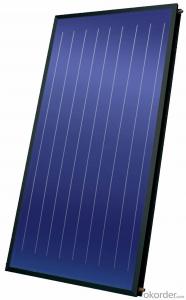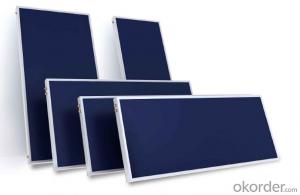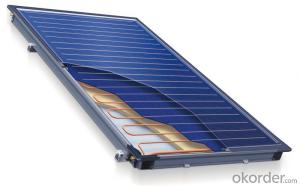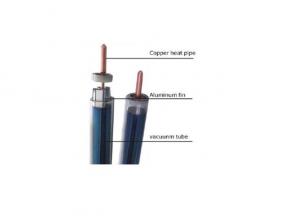Split Pressurized Solar Water Heater
- Loading Port:
- China Main Port
- Payment Terms:
- TT or LC
- Min Order Qty:
- 2 Sets set
- Supply Capability:
- 180000 Sets per Year set/month
OKorder Service Pledge
OKorder Financial Service
You Might Also Like
*Heat collector
*Storage tank
*Working station kit
*Have own factory of vacuum tube
Working principle:
1) When the temperature of the heat collector reaches the set value, the controller will make shall the circulation pump work automatically.
2) The circulation pump makes heat-conducting liquid circulate automatically.
3) The heat-conducting liquid transfers heat to water by the heat exchanger in the tank.
4) In case the temperature of the circulation pump does not reach the set value, the circulation pump will be shut automatically.
5) In case the temperature of the tank does not reach Tm ax, then start the auxiliary heating device.
Feature:
*Collector separates with storage tank. The tank can be put in any place of house. And the collector can be put on the inclined roof or flat place.
*Module design, arbitrary combination, harmony with the building perfectly;
*Intelligent control and automatic operation;
*Anti-freeze: No water inside the tubes when it works.
*The system controller has the anti-freezing function is that the temperature circulation will operate while it reaches the fixed temperature.
*Multifunction: Bathing, washing, domestic heating etc;
*Work at anytime and enjoyable.
Structure:
Model No: 100L 150L 200L 300L
- Q:Can solar collectors be used for drying crops?
- Yes, solar collectors can be used for drying crops. Solar collectors, such as solar dryers, can harness the sun's energy to provide heat for drying agricultural products. This method of crop drying can be more cost-effective and environmentally friendly compared to traditional drying methods.
- Q:What is the effect of dust storms on solar collectors?
- Dust storms can have a negative effect on solar collectors by reducing their efficiency and potentially damaging their surfaces. The dust particles can block sunlight and decrease the amount of solar radiation reaching the collectors, thereby reducing their power output. Additionally, the accumulation of dust on the surface of the collectors can create a barrier that hinders the absorption of sunlight. Regular cleaning and maintenance are necessary to mitigate the impact of dust storms on solar collectors.
- Q:Can solar collectors be used for heating in areas with high pollution?
- Solar collectors can still be utilized for heating purposes in regions with high pollution. While pollution does have some impact on the efficiency of solar panels, they are still capable of producing a significant amount of heat. The primary reliance of solar collectors is on sunlight, and even in heavily polluted areas, there is still sunlight that manages to reach the Earth's surface. However, it should be noted that the level of pollution does influence the overall efficiency and effectiveness of the solar collectors. In areas with severe pollution, the amount of sunlight that reaches the panels may be diminished, resulting in a decrease in the heat produced. Furthermore, pollution can cause the panels to accumulate dust and dirt, which further hampers their efficiency. Therefore, regular cleaning and maintenance of the solar collectors are imperative to ensure optimal performance, particularly in areas with high pollution levels.
- Q:Can solar collectors be used for heating emergency response facilities?
- Yes, solar collectors can be used for heating emergency response facilities. Solar collectors, such as solar thermal systems, can efficiently capture and convert sunlight into heat energy, which can be used for heating water or air in buildings. This renewable energy source can be particularly useful for emergency response facilities as they often require heating during critical situations, especially in areas where grid power may be unreliable or unavailable. Additionally, solar collectors do not produce greenhouse gas emissions, making them a sustainable and environmentally friendly choice for heating emergency response facilities.
- Q:Can solar collectors be used for generating electricity at night?
- No, solar collectors cannot generate electricity at night as they rely on sunlight to produce electrical energy.
- Q:Can solar collectors be used in remote locations?
- Yes, solar collectors can be used in remote locations. Solar collectors are a viable and practical solution for generating electricity or heating water in areas that are not connected to traditional power grids. They can be easily installed and provide a sustainable and reliable source of energy in remote locations where access to conventional power sources may be limited or non-existent. Additionally, their low maintenance requirements make them suitable for remote areas where regular servicing may not be easily accessible.
- Q:Do solar collectors require direct sunlight to work effectively?
- Yes, solar collectors do require direct sunlight to work effectively. Direct sunlight provides the highest amount of solar radiation, which is necessary for optimal energy conversion in solar collectors. While some level of diffuse sunlight can still be captured, direct sunlight ensures the highest efficiency and productivity of solar collectors.
- Q:How do solar collectors affect the humidity levels in a building?
- Solar collectors do not directly affect the humidity levels in a building. However, they may indirectly impact humidity by reducing the need for conventional energy sources, such as fossil fuels, which can produce greenhouse gases that contribute to global warming. As a result, solar collectors can help mitigate climate change, which in turn can affect humidity patterns and levels over time.
- Q:How do solar collectors affect the overall energy efficiency of a building?
- By harnessing the sun's power, solar collectors have the ability to greatly enhance a building's overall energy efficiency. They achieve this by generating clean and renewable energy, thus reducing the dependence on traditional fossil fuels. Consequently, this reduces the building's carbon footprint and aids in combating climate change. Solar collectors possess the capability to convert sunlight into thermal energy, which can be used for various purposes, including water heating and space heating. This obviates the need for conventional heating methods, which often rely on non-renewable energy sources. Consequently, solar collectors have the potential to significantly decrease energy consumption and lower utility bills. The incorporation of solar collectors into a building's energy system also augments its energy independence. By producing their own clean energy, buildings can reduce their reliance on the grid, particularly during peak demand periods. Consequently, this enhances the resilience and dependability of the building's energy supply. Moreover, solar collectors are typically installed on the roof or facade of a building, effectively utilizing previously unused space. This dual-purpose approach enables the efficient utilization of land or rooftop areas, making them particularly suitable for urban environments with restricted space. Additionally, solar collectors can also serve as passive shading devices, diminishing the necessity for air conditioning in warmer climates. Overall, solar collectors exert a positive influence on a building's energy efficiency. They mitigate greenhouse gas emissions, decrease energy consumption, reduce dependence on the grid, and make efficient use of available space. By harnessing the sun's power, solar collectors contribute to a more sustainable and environmentally friendly building design.
- Q:Can solar collectors be used for heating fitness centers?
- Yes, solar collectors can be used for heating fitness centers. Solar thermal systems can efficiently capture and convert sunlight into heat energy, which can then be utilized for space heating and hot water applications in fitness centers. This can help reduce energy costs and greenhouse gas emissions, making it a sustainable and eco-friendly heating solution for such facilities.
1. Manufacturer Overview |
|
|---|---|
| Location | Zhejiang, China |
| Year Established | 2004 |
| Annual Output Value | US$10 Million - US$50 Million |
| Main Markets | North America South America Eastern Europe Southeast Asia Africa Oceania Mid East Eastern Asia Western Europe |
| Company Certifications | ISO 9001:2000 ;CE ;Solar Keymark |
2. Manufacturer Certificates |
|
|---|---|
| a) Certification Name | |
| Range | |
| Reference | |
| Validity Period | |
3. Manufacturer Capability |
|
|---|---|
| a)Trade Capacity | |
| Nearest Port | Shanghai,Ningbo |
| Export Percentage | 51% - 60% |
| No.of Employees in Trade Department | 6-10 People |
| Language Spoken: | English, Chinese |
| b)Factory Information | |
| Factory Size: | 10,000-30,000 square meters |
| No. of Production Lines | Above 10 |
| Contract Manufacturing | OEM Service Offered Design Service Offered Buyer Label Offered |
| Product Price Range | Average |
Send your message to us
Split Pressurized Solar Water Heater
- Loading Port:
- China Main Port
- Payment Terms:
- TT or LC
- Min Order Qty:
- 2 Sets set
- Supply Capability:
- 180000 Sets per Year set/month
OKorder Service Pledge
OKorder Financial Service
Similar products
New products
Hot products
Hot Searches
Related keywords
